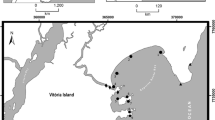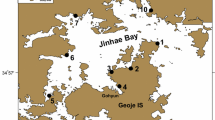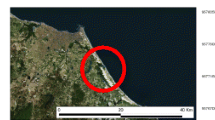Abstract
This work constitutes the first assessment of tributyltin (TBT) pollution levels in the Republic of Cabo Verde (Africa) and proposes the marine gastropod Gemophos viverratus (Kiener, 1834) as a new bioindicator of TBT pollution in the Macaronesia and west coast of Africa. Specimens were collected between August and October 2012 along a gradient of naval traffic in São Vicente Island. The results clearly indicate an increase of imposex levels (percentage of females affected with imposex, 0–100 %; vas deferens sequence index, 0–4.1; relative penis length index, 0–54.6 %) and female TBT contamination (from 5 to 37 ngSn g−1 dry weight (dw)) from outside to inside the harbour of Porto Grande Bay and identify this area as the focus of TBT pollution in the island. The butyltin degradation index for G. viverratus tissues ranged between 1.3 and 2.2, which being above 1 suggests that a considerable part of TBT inputs to the bay may not be very recent. Sterile females were found inside the harbour with an incidence up to 21.4 %. Considering the existence of a planktonic veliger stage in the life cycle of G. viverratus, it is expected that recruitment of newborn individuals can be supplied from unaffected breeding females inside and outside the Porto Grande Bay, resulting in a reduced impact of TBT pollution on population abundance. G. viverratus is very promising to be used as a simple, inexpensive and efficient novel tool for TBT pollution biomonitoring in the Macaronesia and west coast of Africa, a region for which there is an astonishing lack of information concerning levels and ecological impacts of TBT pollution.


Similar content being viewed by others
References
Barroso C, Moreira M, Gibbs P (2000) Comparison of imposex and intersex development in four prosobranch species for TBT monitoring of a southern European estuarine system (Ria de Aveiro, NW Portugal). Mar Ecol Prog Ser 201:221–232. doi:10.3354/meps201221
Barroso C, Moreira M, Bebianno M (2002) Imposex, female sterility and organotin contamination of the prosobranch Nassarius reticulatus from the Portuguese coast. Mar Ecol Prog Ser 230:127–135. doi:10.3354/meps230127
Castro IB, Rossato M, Fillmann G (2012) Imposex reduction and residual butyltin contamination in southern Brazilian harbors. Environ Toxicol Chem 31:947–954. doi:10.1002/etc.1793
Choi M, Moon HB, Yu J et al (2013) Temporal trends (2004-2009) of imposex in rock shells Thais clavigera collected along the Korean coast associated with tributyltin regulation in 2003 and 2008. Arch Environ Contam Toxicol 64:448–455. doi:10.1007/s00244-012-9839-3
Díez S, Ábalos M, Bayona JM (2002) Organotin contamination in sediments from the Western Mediterranean enclosures following 10 years of TBT regulation. Water Res 36:905–918. doi:10.1016/S0043-1354(01)00305-0
ENAPOR (2013) Statistics. Port Grande. Portos de Cabo Verde. http://www.enapor.cv/portal/V10/EN/aspx/estatisticas/estatisticaPorto.aspx?id_linha=764&ms=0-5-17. Accessed 16 Dec 2013
Galante-Oliveira S, Oliveira I, Pacheco M, Barroso CM (2010) Hydrobia ulvae imposex levels at Ria de Aveiro (NW Portugal) between 1998 and 2007: a counter-current bioindicator? J Environ Monit 12:500–507. doi:10.1039/b908597a
Galante-Oliveira S, Oliveira I, Ferreira N et al (2011) Nucella lapillus L. imposex levels after legislation prohibiting TBT antifoulants: temporal trends from 2003 to 2008 along the Portuguese coast. J Environ Monit 13:304–312. doi:10.1039/c0em00140f
Gibbs PE (2009) Long-term tributyltin (TBT)-induced sterilization of neogastropods: persistence of effects in Ocenebra erinacea over 20 years in the vicinity of Falmouth (Cornwall, UK). J Mar Biol Assoc U K 89:135–138. doi:10.1017/S002531548002336
Gibbs PE, Bryan GW, Pascoe PL, Burt GR (1987) The use of the dog-whelk, Nucella lapillus, as an indicator of tributyltin (TBT) contamination. J Mar Biol Assoc U K 67:507–523. doi:10.1017/S0025315400027260
Hoch M (2001) Organotin compounds in the environment—an overview. Appl Geochem 16:719–743. doi:10.1016/S0883-2927(00)00067-6
Lemghich I, Benajiba MH (2007) Survey of imposex in prosobranchs mollusks along the northern Mediterranean coast of Morocco. Ecol Indic 7:209–214. doi:10.1016/j.ecolind.2005.09.007
Marshall DJ, Rajkumar A (2003) Imposex in the indigenous Nassarius kraussianus (Mollusca: Neogastropoda) from South African harbours. Mar Pollut Bull 46:1150–1155. doi:10.1016/S0025-326X(03)00191-7
Mensink BP, ten Hallers-Tjabbes CC, Kralt J et al (1996) Assessment of imposex in the common whelk, Buccinum undatum (L.) from the Eastern Scheldt, The Netherlands. Mar Environ Res 41:315–325. doi:10.1016/0141-1136(95)00022-4
Nyarko E, Evans SM (1997) The impacts of tributyltin, pollution and human food gathering on populations of whelks Thais haemostoma and T. nodosa on the coast of Ghana. In: Evans SM, Vanderpuye CJ, Armah AK (eds) The coastal zone of West Africa: problems and management. Penshaw, Sunderland, pp 93–101
Rees CM, Brady BA, Fabris GJ (2001) Incidence of imposex in Thais orbita from Port Phillip Bay (Victoria, Australia), following 10 years of regulation on use of TBT. Mar Pollut Bull 42:873–878. doi:10.1016/S0025-326X(01)00041-8
Ruiz JM, Quintela M, Barreiro R (1998) Ubiquitous imposex and organotin bioaccumulation in gastropods Nucella lapillus from Galicia (NW Spain): a possible effect of nearshore shipping. Mar Ecol Prog Ser 164:237–244. doi:10.3354/meps164237
Ruiz JM, Barreiro R, Couceiro L, Quintela M (2008) Decreased TBT pollution and changing bioaccumulation pattern in gastropods imply butyltin desorption from sediments. Chemosphere 73:1253–1257. doi:10.1016/j.chemosphere.2008.07.029
Schulte-Oehlmann U, Oehlmann J, Fioroni P, Bauer B (1997) Imposex and reproductive failure in Hydrobia ulvae (Gastropoda: Prosobranchia). Mar Biol 128:257–266. doi:10.1007/s002270050090
Shi H, Huang C, Yu X, Zhu S (2005) An updated scheme of imposex for Cantharus cecillei (Gastropoda: Buccinidae) and a new mechanism leading to the sterilization of imposex-affected females. Mar Biol 146:717–723. doi:10.1007/s00227-004-1475-7
Silva MNP (2005) Caracterização ambiental e proposta de gestão integrada para o litoral da cidade do Mindelo (S. Vicente – Cabo Verde). Dissertation, Universidade Nova de Lisboa (in Portuguese)
Smith BS (1971) Sexuality in the American mud snail Nassarius obsoletus (Say). Proc Malacol Soc Lond 39:377–378
Sousa A, Mendo S, Barroso C (2005) Imposex and organotin contamination in Nassarius reticulatus (L.) along the Portuguese coast. Appl Organomet Chem 19:315–323. doi:10.1002/aoc.856
Sousa A, Matsudaira C, Takahashi S et al (2007) Integrative assessment of organotin contamination in a southern European estuarine system (Ria de Aveiro, NW Portugal): tracking temporal trends in order to evaluate the effectiveness of the EU ban. Mar Pollut Bull 54:1645–1653. doi:10.1016/j.marpolbul.2007.07.005
Sousa A, Ikemoto T, Takahashi S et al (2009) Distribution of synthetic organotins and total tin levels in Mytilus galloprovincialis along the Portuguese coast. Mar Pollut Bull 58:1130–1136. doi:10.1016/j.marpolbul.2009.04.007
Stroben E, Oehlmann J, Fioroni P (1992) The morphological expression of imposex in Hinia reticulata (Gastropoda: Buccinidae): a potential indicator of tributyltin pollution. Mar Biol 113:625–636. doi:10.1007/BF00349706
Titley-O’Neal CP, Munkittrick KR, Macdonald BA (2011) The effects of organotin on female gastropods. J Environ Monit 13:2360–2388. doi:10.1039/c1em10011d
Acknowledgments
The authors thank the valuable assistance of the MSc Felipe Ribas who illustrated the VDS scheme for G. viverratus presented in this work. This work was financially supported by the Portuguese Foundation for Science and Technology (FCT) through the program COMPETE and the project CESAM-PEst-C/MAR/LA0017/2013.
Author information
Authors and Affiliations
Corresponding author
Additional information
Responsible editor: Philippe Garrigues
Rights and permissions
About this article
Cite this article
Lopes-dos-Santos, R.M.A., Galante-Oliveira, S., Lopes, E. et al. Assessment of imposex and butyltin concentrations in Gemophos viverratus (Kiener, 1834), from São Vicente, Republic of Cabo Verde (Africa). Environ Sci Pollut Res 21, 10671–10677 (2014). https://doi.org/10.1007/s11356-014-3068-4
Received:
Accepted:
Published:
Issue Date:
DOI: https://doi.org/10.1007/s11356-014-3068-4




